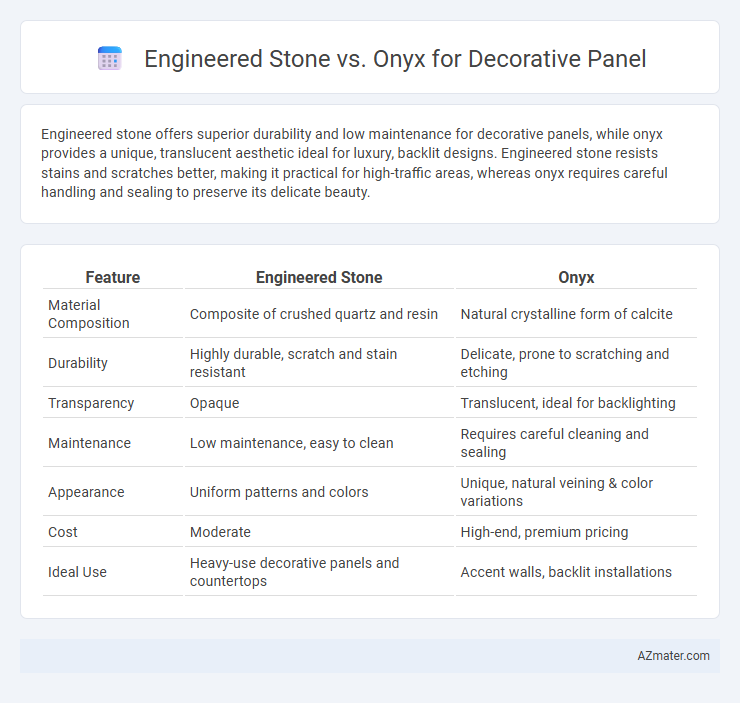Engineered stone offers superior durability and low maintenance for decorative panels, while onyx provides a unique, translucent aesthetic ideal for luxury, backlit designs. Engineered stone resists stains and scratches better, making it practical for high-traffic areas, whereas onyx requires careful handling and sealing to preserve its delicate beauty.
Table of Comparison
| Feature | Engineered Stone | Onyx |
|---|---|---|
| Material Composition | Composite of crushed quartz and resin | Natural crystalline form of calcite |
| Durability | Highly durable, scratch and stain resistant | Delicate, prone to scratching and etching |
| Transparency | Opaque | Translucent, ideal for backlighting |
| Maintenance | Low maintenance, easy to clean | Requires careful cleaning and sealing |
| Appearance | Uniform patterns and colors | Unique, natural veining & color variations |
| Cost | Moderate | High-end, premium pricing |
| Ideal Use | Heavy-use decorative panels and countertops | Accent walls, backlit installations |
Introduction to Engineered Stone and Onyx Panels
Engineered stone panels combine natural quartz crystals with resin binders, offering high durability, stain resistance, and uniform appearance ideal for decorative applications. Onyx panels, composed of translucent natural calcite, showcase vibrant veining and dramatic lighting effects, making them a premium choice for luxury interiors. Both materials serve distinct aesthetic and functional roles, with engineered stone excelling in practicality and onyx prized for its visual impact.
Composition and Formation Differences
Engineered stone is composed primarily of crushed natural quartz mixed with resin and pigments, creating a durable, non-porous surface ideal for decorative panels. Onyx, a natural stone formed through the crystallization of calcium carbonate in stalactitic caves, features translucent, layered patterns with a softer, more fragile structure. The synthetic binding in engineered stone enhances resistance to staining and impact, whereas onyx's natural formation offers unique aesthetic veining but requires more careful maintenance.
Aesthetic Appeal and Design Versatility
Engineered stone offers a consistent uniformity and a wide range of color options, making it ideal for sleek, modern decorative panels with high durability. Onyx delivers a unique translucency and natural patterns that create striking visual depth and luxury, often enhanced by backlighting techniques. Design versatility in engineered stone lies in its adaptability to various finishes, while onyx panels stand out for their dramatic aesthetic impact in upscale interior environments.
Durability and Longevity Comparison
Engineered stone offers superior durability with high resistance to scratches, stains, and impact, making it ideal for long-lasting decorative panels in high-traffic areas. Onyx, while visually striking with its translucent quality and unique veining, is more prone to scratching, chipping, and requires careful maintenance to preserve its appearance over time. The lifespan of engineered stone panels generally surpasses that of onyx, providing a more practical solution for durability without compromising aesthetic appeal.
Maintenance and Cleaning Requirements
Engineered stone offers superior durability and stain resistance, requiring only regular wiping with mild soap and water to maintain its appearance, making it highly low-maintenance for decorative panels. Onyx, while prized for its translucent beauty and unique patterns, demands more delicate care, including avoiding harsh chemicals and abrasive cleaners to prevent surface damage. Proper sealing and gentle cleaning are essential to preserve onyx's natural luster and prevent etching or discoloration over time.
Cost Analysis: Engineered Stone vs Onyx
Engineered stone offers a cost-effective solution for decorative panels, typically priced between $40 and $70 per square foot, making it more accessible for large-scale installations. Onyx, known for its luxurious appearance and translucency, can cost upwards of $100 to $250 per square foot due to its rarity and the complexity of quarrying and fabrication. Maintenance and durability also influence long-term expenses, with engineered stone providing greater resistance to scratches and stains compared to the more delicate and higher-maintenance onyx.
Sustainability and Environmental Impact
Engineered stone offers enhanced sustainability with its use of recycled materials and lower resource consumption compared to natural stone. Onyx, a natural stone, requires extensive quarrying that results in significant environmental disruption and higher carbon emissions. Choosing engineered stone for decorative panels reduces landfill waste and promotes eco-friendly manufacturing processes, aligning with sustainable building practices.
Installation Process and Practical Considerations
Engineered stone offers a straightforward installation process due to its uniform thickness and consistent composition, allowing for precise cutting and easy handling, which reduces labor time and costs. Onyx, while visually striking with its translucent qualities, requires more skilled installation because of its fragility and variable thickness, necessitating careful support and specialized adhesives to prevent damage. Practical considerations for engineered stone include its durability, resistance to staining, and low maintenance, whereas onyx demands careful upkeep, sensitivity to acids, and may require protective sealing to maintain its aesthetic appeal.
Common Applications in Interior Design
Engineered stone is widely used for kitchen countertops, bathroom vanities, and flooring due to its durability and resistance to stains and scratches. Onyx panels are prized for accent walls, backlit feature panels, and decorative partitions, offering unique translucency and luxurious aesthetics. Both materials enhance interior design by combining functionality with distinctive visual appeal, but engineered stone is preferred for high-traffic surfaces while onyx excels in creating striking focal points.
Choosing the Right Material for Decorative Panels
Engineered stone offers exceptional durability, stain resistance, and low maintenance, making it ideal for high-traffic decorative panels in commercial and residential spaces. Onyx, prized for its translucent beauty and unique veining, provides a luxurious aesthetic but requires careful handling and sealing due to its softness and porosity. Selecting the right material depends on balancing durability needs with design goals, where engineered stone suits practical applications and onyx excels in creating dramatic, light-enhanced features.

Infographic: Engineered stone vs Onyx for Decorative Panel
 azmater.com
azmater.com